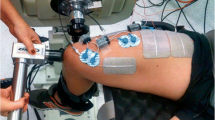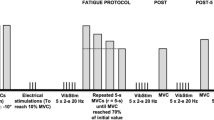Abstract
Purpose
The present study aimed to directly compare the effects of 30 min muscle (VIBmuscle) vs. tendon (VIBtendon) local vibration (LV) to the quadriceps on maximal voluntary isometric contraction (MVIC) and rate of torque development (RTD) as well as on central nervous system excitability (i.e. motoneuron and cortical excitability).
Methods
Before (PRE) and immediately after (POST) LV applied to the quadriceps muscle or its tendon, we investigated MVIC and RTD (STUDY #1; n = 20) or vastus lateralis (VL), vastus medialis (VM) and rectus femoris (RF) electromyography responses to thoracic electrical stimulation (TMEPs; motoneuron excitability) and transcranial magnetic stimulation (MEPs; corticospinal excitability) (STUDY #2; n = 17). MEP/TMEP ratios were further calculated to quantify changes in cortical excitability.
Results
MVIC decreased at POST (P = 0.017) without any difference between VIBtendon and VIBmuscle, while RTD decreased for VIBtendon (P = 0.013) but not VIBmuscle. TMEP amplitudes were significantly decreased for all muscles (P = 0.014, P < 0.001 and P = 0.004 for VL, VM and RF, respectively) for both LV sites. While no changes were observed for MEP amplitude, MEP/TMEP ratios increased at POST for VM and RF muscles (P = 0.009 and P = 0.013, respectively) for both VIBtendon and VIBmuscle.
Conclusion
The present results suggest that prolonged muscle and tendon LV are similarly effective in modulating central nervous system excitability and decreasing maximal force. Yet, altered explosive performance after tendon but not muscle LV suggests greater neural alterations when tendons are vibrated.



Similar content being viewed by others
Abbreviations
- EMG:
-
Electromyography
- LV:
-
Local vibration
- MEP:
-
Motor evoked potential
- Mmax :
-
Resting maximal M-wave
- MVIC:
-
Maximal voluntary isometric contraction
- PNS:
-
Peripheral nerve stimulation
- POST:
-
After
- PRE:
-
Before
- RF:
-
Rectus femoris
- RTD:
-
Rate of torque development
- TES:
-
Thoracic electrical stimulation
- TMEP:
-
Thoracic MEP
- TMS:
-
Transcranial magnetic stimulation
- VIBmuscle :
-
Muscle local vibration
- VIBtendon :
-
Tendon local vibration
- VL:
-
Vastus lateralis
- VM:
-
Vastus medialis
References
Barrera-Curiel A, Colquhoun RJ, Hernandez-Sarabia JA, DeFreitas JM (2019) The effects of vibration-induced altered stretch reflex sensitivity on maximal motor unit firing properties. J Neurophysiol 121:2215–2221. https://doi.org/10.1152/jn.00326.2018
Brownstein CG, Souron R, Royer N et al (1985) (2020) Disparate kinetics of change in responses to electrical stimulation at the thoracic and lumbar level during fatiguing isometric knee extension. J Appl Physiol 128:159–167. https://doi.org/10.1152/japplphysiol.00635.2019
Burke D, Hagbarth KE, Löfstedt L, Wallin BG (1976) The responses of human muscle spindle endings to vibration of non-contracting muscles. J Physiol 261:673–693. https://doi.org/10.1113/jphysiol.1976.sp011580
Celletti C, Suppa A, Bianchini E et al (2020) Promoting post-stroke recovery through focal or whole body vibration: criticisms and prospects from a narrative review. Neurol Sci 41:11–24. https://doi.org/10.1007/s10072-019-04047-3
Cohen J (1988) Statistical Power Analysis for the Behavioral Sciences, 2nd edn. Routledge, New York
Coulondre C, Souron R, Rambaud A et al (2021) Local vibration training improves the recovery of quadriceps strength in early rehabilitation after anterior cruciate ligament reconstruction: a feasibility randomized controlled trial. Ann Phys Rehabil Med. https://doi.org/10.1016/j.rehab.2020.08.005
de Ruiter CJ, van der Linden RM, van der Zijden MJA et al (2003) Short-term effects of whole-body vibration on maximal voluntary isometric knee extensor force and rate of force rise. Eur J Appl Physiol 88:472–475. https://doi.org/10.1007/s00421-002-0723-0
Del Vecchio A, Negro F, Holobar A et al (2019) You are as fast as your motor neurons: speed of recruitment and maximal discharge of motor neurons determine the maximal rate of force development in humans. J Physiol 597:2445–2456. https://doi.org/10.1113/JP277396
Del Vecchio A, Casolo A, Dideriksen JL et al (2022) Lack of increased rate of force development after strength training is explained by specific neural, not muscular, motor unit adaptations. J Appl Physiol 132:84–94. https://doi.org/10.1152/japplphysiol.00218.2021
Devanne H, Lavoie BA, Capaday C (1997) Input-output properties and gain changes in the human corticospinal pathway. Exp Brain Res 114:329–338. https://doi.org/10.1007/pl00005641
Eklund G, Hagbarth K-E (1966) Normal variability of tonic vibration reflexes in man. Exp Neurol 16:80–92. https://doi.org/10.1016/0014-4886(66)90088-4
Fattorini L, Rodio A, Pettorossi VE, Filippi GM (2021) Is the Focal Muscle Vibration an Effective Motor Conditioning Intervention? A Systematic Review. Journal of Functional Morphology and Kinesiology 6:39. https://doi.org/10.3390/jfmk6020039
Feltroni L, Monteleone S, Petrucci L et al (2018) Potentiation of muscle strength by focal vibratory stimulation on quadriceps femoris. G Ital Med Lav Ergon 40:90–96
Fry A, Folland JP (2014) Prolonged infrapatellar tendon vibration does not influence quadriceps maximal or explosive isometric force production in man. Eur J Appl Physiol 114:1757–1766. https://doi.org/10.1007/s00421-014-2904-z
Gail PD, Lance JW, Neilson PD (1966) Differential effects on tonic and phasic reflex mechanisms produced by vibration of muscles in man. J Neurol Neurosurg Psychiatry 29:1–11. https://doi.org/10.1136/jnnp.29.1.1
Gandevia SC, Herbert RD, Leeper JB (1998) Voluntary activation of human elbow flexor muscles during maximal concentric contractions. J Physiol 512(Pt 2):595–602. https://doi.org/10.1111/j.1469-7793.1998.595be.x
Iodice P, Bellomo RG, Gialluca G et al (2011) Acute and cumulative effects of focused high-frequency vibrations on the endocrine system and muscle strength. Eur J Appl Physiol 111:897–904. https://doi.org/10.1007/s00421-010-1677-2
Jackson SW, Turner DL (2003) Prolonged muscle vibration reduces maximal voluntary knee extension performance in both the ipsilateral and the contralateral limb in man. Eur J Appl Physiol 88:380–386. https://doi.org/10.1007/s00421-002-0701-6
Konishi Y, Fukubayashi T, Takeshita D (2002) Mechanism of Quadriceps Femoris Muscle Weakness in Patients with Anterior Cruciate Ligament Reconstruction. Scand J Med Sci Sports 12:371–375. https://doi.org/10.1034/j.1600-0838.2002.01293.x
Konishi Y, Kubo J, Fukudome A (2009) Effects of prolonged tendon vibration stimulation on eccentric and concentric maximal torque and emgs of the knee extensors. J Sports Sci Med 8:548–552
Kouzaki M, Shinohara M, Fukunaga T (2000) Decrease in Maximal Voluntary Contraction by Tonic Vibration Applied to a Single Synergist Muscle in Humans. J Appl Physiol 89:1420–1424. https://doi.org/10.1152/jappl.2000.89.4.1420
Lapole T, Deroussen F, Pérot C, Petitjean M (2012) Acute effects of Achilles tendon vibration on soleus and tibialis anterior spinal and cortical excitability. Appl Physiol Nutr Metab 37:657–663. https://doi.org/10.1139/h2012-032
Maffiuletti NA, Aagaard P, Blazevich AJ et al (2016) Rate of force development: physiological and methodological considerations. Eur J Appl Physiol 116:1091–1116. https://doi.org/10.1007/s00421-016-3346-6
McNeil CJ, Butler JE, Taylor JL, Gandevia SC (2013) Testing the excitability of human motoneurons. Front Hum Neurosci 7:152. https://doi.org/10.3389/fnhum.2013.00152
Nito M, Yoshimoto T, Hashizume W et al (2021) Vibration decreases the responsiveness of Ia afferents and spinal motoneurons in humans. J Neurophysiol 126:1137–1147. https://doi.org/10.1152/jn.00168.2021
Pietrangelo T, Mancinelli R, Toniolo L et al (2009) Effects of local vibrations on skeletal muscle trophism in elderly people: mechanical, cellular, and molecular events. Int J Mol Med 24:503–512. https://doi.org/10.3892/ijmm_00000259
Richardson MS, Cramer JT, Bemben DA et al (2006) Effects of age and ACL reconstruction on quadriceps gamma loop function. J Geriatr Phys Ther 29:28–34
Rittweger J (2010) Vibration as an exercise modality: how it may work, and what its potential might be. Eur J Appl Physiol 108:877–904. https://doi.org/10.1007/s00421-009-1303-3
Ritzmann R, Stark C, Krause A (2018) Vibration therapy in patients with cerebral palsy: a systematic review. Neuropsychiatr Dis Treat 14:1607–1625. https://doi.org/10.2147/NDT.S152543
Roll JP, Vedel JP, Ribot E (1989) Alteration of proprioceptive messages induced by tendon vibration in man: a microneurographic study. Exp Brain Res 76:213–222. https://doi.org/10.1007/BF00253639
Rossi S, Hallett M, Rossini PM, Pascual-Leone A (2011) Screening questionnaire before TMS: An update. Clin Neurophysiol 122:1686. https://doi.org/10.1016/j.clinph.2010.12.037
Saito A, Ando R, Akima H (2016a) Effects of prolonged patellar tendon vibration on force steadiness in quadriceps femoris during force-matching task. Exp Brain Res 234:209–217. https://doi.org/10.1007/s00221-015-4447-x
Saito A, Ando R, Akima H (2016b) Effects of Prolonged Vibration to Vastus Intermedius Muscle on Force Steadiness of Knee Extensor Muscles during Isometric Force-Matching Task. Journal of Electromyography and Kinesiology: Official Journal of the International Society of Electrophysiological Kinesiology 31:48–54. https://doi.org/10.1016/j.jelekin.2016.09.002
Siggelkow S, Kossev A, Schubert M et al (1999) Modulation of motor evoked potentials by muscle vibration: the role of vibration frequency. Muscle Nerve 22:1544–1548. https://doi.org/10.1002/(sici)1097-4598(199911)22:11%3c1544::aid-mus9%3e3.0.co;2-8
Souron R, Besson T, McNeil CJ et al (2017a) An Acute Exposure to Muscle Vibration Decreases Knee Extensors Force Production and Modulates Associated Central Nervous System Excitability. Front Hum Neurosci. https://doi.org/10.3389/fnhum.2017.00519
Souron R, Besson T, Millet GY, Lapole T (2017b) Acute and chronic neuromuscular adaptations to local vibration training. Eur J Appl Physiol 117:1939–1964. https://doi.org/10.1007/s00421-017-3688-8
Souron R, Besson T, Lapole T, Millet GY (2018a) Neural adaptations in quadriceps muscle after 4 weeks of local vibration training in young versus older subjects. Appl Physiol Nutr Metab 43:427–436. https://doi.org/10.1139/apnm-2017-0612
Souron R, Oriol M, Millet GY, Lapole T (2018b) Intermediate Muscle Length and Tendon Vibration Optimize Corticospinal Excitability During Knee Extensors Local Vibration. Front Physiol 9:1266. https://doi.org/10.3389/fphys.2018.01266
Souron R, Baudry S, Millet GY, Lapole T (2019) Vibration-induced depression in spinal loop excitability revisited. J Physiol 597:5179–5193. https://doi.org/10.1113/JP278469
Steyvers M, Levin O, Verschueren SM, Swinnen SP (2003) Frequency-dependent effects of muscle tendon vibration on corticospinal excitability: a TMS study. Exp Brain Res 151:9–14. https://doi.org/10.1007/s00221-003-1427-3
Tankisheva E, Bogaerts A, Boonen S et al (2015) Effects of a Six-Month Local Vibration Training on Bone Density, Muscle Strength, Muscle Mass, and Physical Performance in Postmenopausal Women. J Strength Cond Res 29:2613–2622. https://doi.org/10.1519/JSC.0000000000000895
Ugawa Y, Genba-Shimizu K, Kanazawa I (1995) Electrical stimulation of the human descending motor tracts at several levels. Can J Neurol Sci 22:36–42. https://doi.org/10.1017/s0317167100040476
Ushiyama J, Masani K, Kouzaki M et al (1985) (2005) Difference in aftereffects following prolonged Achilles tendon vibration on muscle activity during maximal voluntary contraction among plantar flexor synergists. J Appl Physiol 98:1427–1433. https://doi.org/10.1152/japplphysiol.00613.2004
Varesco G, Espeit L, Feasson L et al (2019) Rate of force development and rapid muscle activation characteristics of knee extensors in very old men. Exp Gerontol 124:110640. https://doi.org/10.1016/j.exger.2019.110640
Viseux F, Lemaire A, Barbier F et al (2019) How can the stimulation of plantar cutaneous receptors improve postural control? Review and clinical commentary. Neurophysiol Clin 49:263–268. https://doi.org/10.1016/j.neucli.2018.12.006
Author information
Authors and Affiliations
Contributions
DK, RS, GYM and TL conceived and designed research. DK, GV and LE conducted experiments. DK, GV and TL analyzed data. DK, GV and TL wrote the manuscript. All authors read and approved the manuscript
Corresponding author
Ethics declarations
Conflict of interest
None.
Additional information
Communicated by Toshio Moritani.
Publisher's Note
Springer Nature remains neutral with regard to jurisdictional claims in published maps and institutional affiliations.
Rights and permissions
Springer Nature or its licensor holds exclusive rights to this article under a publishing agreement with the author(s) or other rightsholder(s); author self-archiving of the accepted manuscript version of this article is solely governed by the terms of such publishing agreement and applicable law.
About this article
Cite this article
Kennouche, D., Varesco, G., Espeit, L. et al. Acute effects of quadriceps muscle versus tendon prolonged local vibration on force production capacities and central nervous system excitability. Eur J Appl Physiol 122, 2451–2461 (2022). https://doi.org/10.1007/s00421-022-05028-9
Received:
Accepted:
Published:
Issue Date:
DOI: https://doi.org/10.1007/s00421-022-05028-9




